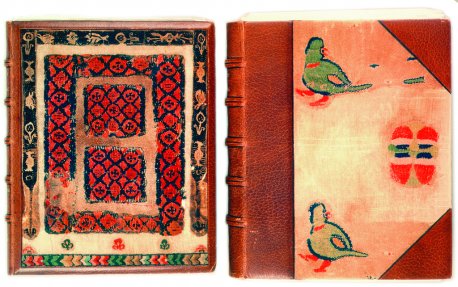The Text and The Textile Albums: Antinoé et les Sépultures de Thaïs et Sérapion Fantomes d‘Antinoé, Les Sépultures de Leukyoné et Myrithis
Mummy-Mania
The Text and The Textile Albums: Antinoé et les Sépultures de Thaïs et Sérapion Fantomes d‘Antinoé, Les Sépultures de Leukyoné et Myrithis [ edit ]
Two books by Albert Gayet are bound in The Text Album: Antinoé et les Sépultures de Thaïs et Sérapion Fantomes d‘Antinoé, and Les Sépultures de Leukyoné et Myrithis. In addition, Thirty fabrics are pasted in the album. In The Textile Album, one hundred fourteen fabrics and eight artifacts are present. Photo by Richard Nicol. Autographed in French by Al. Gayet (translation by the author): “The exploration of Antinoé is the resurrection of a world. This statement by a foreigner, a German scholar, has hardly found any response in France, except among some savants.” Two 1913 letters from Albert Gayet that came with the albums identify Henry Bryon as the owner of the two albums. Bryon probably acquired the textiles and artifacts at the 1901 sale of the Gayet grave goods. Either Bryon or the Parisian bookbinder Joly Fils arranged the covers, pages, and box. After seeing the albums at Bryon’s invitation Gayet wrote, “The albums are charming and executed with perfect artistic talent.” The albums were sold at a Hotel Drouot auction in 1928 by a Monsieur X, purchased from an antiquarian book shop in Los Angeles in 1947 or 48 by Helen Stager Poulsen, and donated by her to the Henry Art Gallery’s textile collection at the University of Washington in 1983.
The collection is unusual because The Text and Textile Albums are a creative work of book art in their own right. The collection is unique because the album covers and six other pages are decorated with a collage of fabric fragments. Other album pages have one large remnant or a few small fragments artfully arranged. A shallow box with an assemblage of textiles and artifacts is at the back of The Textile Album. The box is as weird, wonderful, and quixotic as a Joseph Cornell with a decorative headband, a lock of hair in a round glass-covered box, a cap, a sandal, a leather strap, a weaver’s comb, a spindle shank, spindle whorls, and tapestry, tablet woven, or embroidered fragments. With the exception of six embroidered fragments, which are probably Mamluk (thirteenth to sixteenth century CE), and some tapestries that are Early Islamic (mid-seventh to twelfth century CE), the album fabrics are Coptic (late third to mid-seventh century CE). The album textile fragments are important because they match or are closely related to those in the Musée du Louvre and other major museum collections of Coptic cloth.
Dimensions
The Text Album: 28.6cm x 24.8 cm x 4.8 cm; The Textile Album: 28.6 cm x 24.8 cm x 7.6 cm
Artist or Author
Album Artist: Henry Byron; Archaeologist: Albert Gayet
Museum
Henry Art Gallery
Accession Number
Text Album: 83.7-1 to 8; Textile Album: 83.7-9 to 73















